
Managing diabetes effectively requires a well-planned diet. In this guide, we’ll explore the importance of a diabetic diet chart, how to create one, and tips for maintaining a healthy lifestyle.
Understanding the Importance of a Diabetic Diet Chart
What is a Diabetic Diet Chart?
A diabetic diet chart is a structured plan that outlines what a person with diabetes should eat in a day to manage their blood sugar levels effectively. It includes a balanced intake of macronutrients, fiber, and other essential nutrients. Following a diabetic diet chart can help maintain blood glucose levels, reduce the risk of complications, and improve overall health.
Key Components of an Effective Diabetic Diet
A well-rounded diabetic diet includes a balance of carbohydrates, proteins, and fats. Emphasis should be on whole grains, lean proteins, healthy fats, and plenty of vegetables. Fiber is crucial as it helps in controlling blood sugar levels. Incorporating foods with low glycemic index (GI) is also beneficial in managing diabetes.
Download Free Diabetic Diet Chart, Diet Plan With Recipes
Creating Your Personalized Diabetic Diet Chart
Assessing Your Dietary Needs
Before creating a diabetic diet chart, it’s important to assess your individual dietary needs. This includes calculating your daily calorie intake based on your age, sex, weight, height, and activity level. Understanding your macronutrient requirements will help tailor your diet to manage diabetes effectively. Consulting with a healthcare provider or a nutritionist can provide personalized recommendations.
Choosing the Right Foods
Choosing the right foods is crucial in managing diabetes. Include plenty of vegetables, whole grains, lean proteins, and healthy fats in your diet. Avoid sugary foods, refined carbs, and unhealthy fats. Focus on foods that have a low glycemic index to help maintain steady blood sugar levels. Here are some examples:
- Vegetables: Spinach, broccoli, cauliflower
- Proteins: Chicken breast, tofu, beans
- Fats: Avocado, nuts, olive oil
Also visit: Best Ayurvedic Medicine for Diabetes | Herbal Diabetes Capsules
Sample Diabetic Diet Chart for Daily Use
Breakfast Ideas
Starting your day with a healthy breakfast is essential. Here are some breakfast ideas for diabetics:
- Oatmeal with Berries: Rich in fiber and low in GI.
- Greek Yogurt with Nuts: High in protein and healthy fats.
- Vegetable Omelette: Packed with nutrients and low in carbs.
Lunch and Dinner Plans
For lunch and dinner, focus on balanced meals that include a good mix of protein, fiber, and healthy fats:
- Grilled Chicken Salad: With mixed greens and vinaigrette.
- Quinoa and Vegetable Stir-fry: A nutritious and filling meal.
- Fish with Steamed Vegetables: Low in carbs and high in omega-3 fatty acids.
Best Diabetic Diet Chart Plan to Control Diabetes in an Easy Way
Diabetes is not always difficult to manage. But if it is neglected then diabetic patients have to face some serious consequences. So, to avoid those consequences and to live a healthy life do some proper exercises, medication, and follow a diabetes diet chart.
Firstly, it is necessary to understand diabetes and how it impacts food in order to know what kinds of foods a diabetic patient should eat for improved health. With proper food, frequent exercise, and weight control, diabetes can be effectively treated. It is advised that you stick to the best diet plan for diabetes patients.
This article contains an in-depth diabetes diet chart which is designed to help people with diabetes in controlling their blood sugar levels. Let’s get started!
DOWNLOAD 7 DAYS DIABETIC DIET CHART FOR FREE
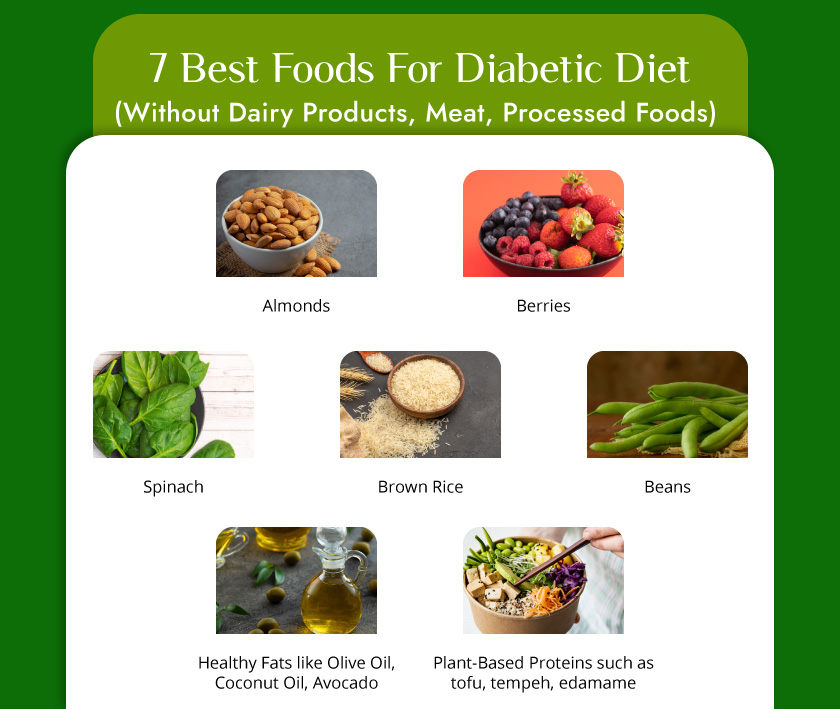
1. To follow the customized Sugar Patient Diet chart, Understand What is Diabetes:
People of all ages are subject to the typical disease known as diabetes. The basic root cause of diabetes is an excessive amount of glucose (or sugar) in the blood. It happens when the pancreas either does not make enough insulin or the body’s cells lose their sensitivity to insulin and do not take up glucose as they usually should.
There are mainly three types of diabetes.
1. Type 1: An autoimmune condition is type one diabetes. The cells in the pancreas that make insulin are attacked by this.
2. Type 2: When the body grows resistant to insulin, type two diabetes occurs. The blood sugar level increases during this phase.
3. Gestational diabetes: Pregnancy-related high levels of sugar in the blood are known as gestational diabetes.
The majority of diabetes types are chronic (lifelong), but all of them can be controlled with healthy lifestyle modifications, medication, along with practicing the proper food chart for diabetes.
2. What is the Need for a food chart for Diabetic?
A person with diabetes is advised to actively engage in self-management, education, and medical planning in addition to developing a customized sugar patient diet chart.
The best diet plan for diabetes patients serves as a roadmap for when, what, and how much food to consume in order to meet your nutritional needs and maintain blood sugar levels within the desired range. In addition to whatever medications you’re taking, a smart diabetes diet chart will take your goals, dietary preferences, and lifestyle into account.
[How To Reverse Diabetes Permanently before its too late]
3. What Kinds of Food Should be Included in the Diet Chart for Diabetes Patients?
A good diabetes diet chart should include:
- Increase your consumption of non-starchy veggies including green beans, spinach, and broccoli.
- Reduce the number of refined carbohydrates and added sugars you consume, such as white bread, rice, and pasta with less than 2 grams of fiber per serving.
- As far as possible, emphasize whole meals rather than heavily processed ones.
- A 1200–1500 calorie diet is typically seen as a decent type 1 or type 2 diabetes diet chart to follow to maintain a healthy blood sugar level and weight.
- Based on factors such as age, weight, BMI, gender, lifestyle, dietary preferences, coexisting diseases, medications you are taking, etc., a sugar patient diet chart may be different for each individual.
- So, it is advised that you speak with a trained nutritionist who will create the finest diabetes diet chart for diabetes patients.
4. 7 days Diabetic diet chart (Without Dairy Products, Meat, Processed Foods)
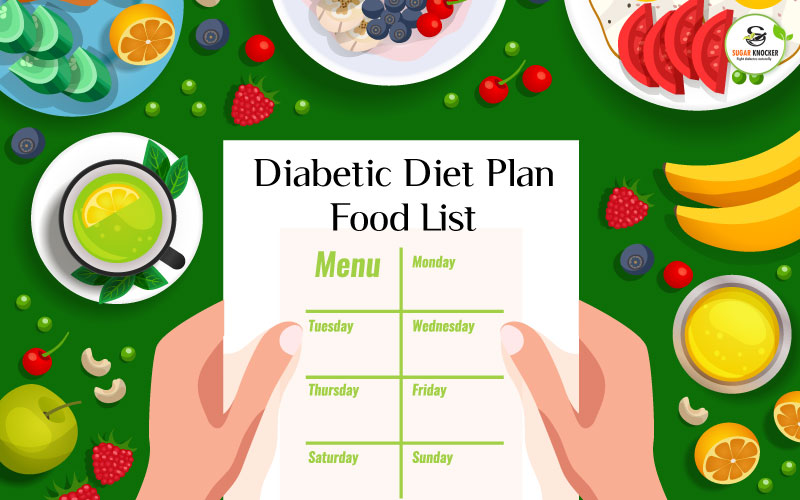
By following the right diabetes diet chart, you can easily control your diabetes. After waking up in the morning, avoid drinking tea or coffee. Instead of that, you can drink fenugreek water or eat soaked nuts, such as walnuts or almonds, if you prefer a lower-sugar diet. The following is an example of the best diet chart for diabetes patients:
4.1. Monday Diabetic Diet Food List
Breakfast - Vegetable Dalia/vegetable paratha/poached egg with whole-wheat toast. Add on grilled vegetables with a cup of coffee/tea/green tea
Mid-morning snack - Low glycemic fruits like apple, orange, pear, guava, etc.
Lunch - 1 or 2 chapattis, vegetables, a bowl of curd, chicken, or dal.
Evening Snack - A bowl of soup, roasted chana, or makhana.
Dinner - 1 or 2 chapatis, a bowl of green vegetables, a bowl of dal or curd, and a plate of salad.
4.2. Tuesday Diabetic Diet Food List
Breakfast - Oats, milk or Dhalia, egg whites, whole-wheat toast, grilled vegetables, and a cup of tea/coffee using low-fat milk.
Mid-morning Snack - About 400 ml buttermilk.
Lunch - 2 chapatis kneaded with boiled dal, a bowl of curd, and vegetable salad.
Evening Snack - A bowl of sprouts or roasted chana or a bowl of fruits like orange, apple, pear, etc.
Dinner - 1 or 2 chapatis, salad, a bowl of dal or fish, and mixed vegetables.
4.3. Wednesday Diabetic Diet Food List
Breakfast - Milk with oats/vegetable oats, poached egg, grilled vegetables, tea/coffee using low-fat milk, and 1 or 2 toasted whole-wheat bread.
Mid-morning Snack - Low glycemic fruits bowl.
Lunch - 1 or 2 chapatis using 50% jowar, about 70 grams of low-fat paneer or chicken, vegetable salad.
Evening Snack - A bowl of popcorn or roasted chana
Dinner - 1 or 2 chapatis, a bow of green leafy vegetables, a bowl of dal, and salad.
4.4. Thursday Diabetic Diet Food List
Breakfast - Vegetable poha or upma, Idli, and a cup of tea or coffee using low-fat milk.
Mid-morning snack - Salted lassi or about 400 ml buttermilk.
Lunch - 1 or 2 chapatis with 50% ragi, a bowl of vegetables, and low-fat curd or paneer.
Evening Snack - A bowl of fruits or a bowl of roasted chana.
Dinner - 1 or 2 besan chilla or vegetable oats with a bowl of fish or dal and a salad plate.
4.5. Friday Diabetic Diet Food List
Breakfast - Chicken sandwich or vegetable sandwich using whole-wheat bread with a cup of tea or coffee or low-fat milk.
Mid-morning snack - A bowl of low glycemic fruits
Lunch - 1 or 2 chapatis with 50% chana flour, mixed vegetable bowl, one bowl of curd, low-fat paneer cubes, and a salad plate.
Evening Snack - A bowl of vegetable or chicken soup and roasted chana
Dinner - 1 or 2 chapatis with 50% chana flour, a plate of salad, a bowl of dal or fish, and mixed vegetables.
4.6. Saturday Diabetic Diet Food List
Breakfast - Moong dal chilla or vegetable stuffed chapatti with a cup of coffee or tea or low-fat milk.
Mid-morning snack – A bowl of sugar-free fruits custard
Lunch - 1 or 2 chapatis kneaded with green leafy vegetables, two eggs white curry, or a bowl of sprouts and vegetables.
Evening Snack - a bowl of curd or fruits or roasted chana
Dinner - 1 or 2 chapatis with dal or curd, a plate of salad, and a bowl of vegetables.
4.7. Sunday Diabetic Diet Food List
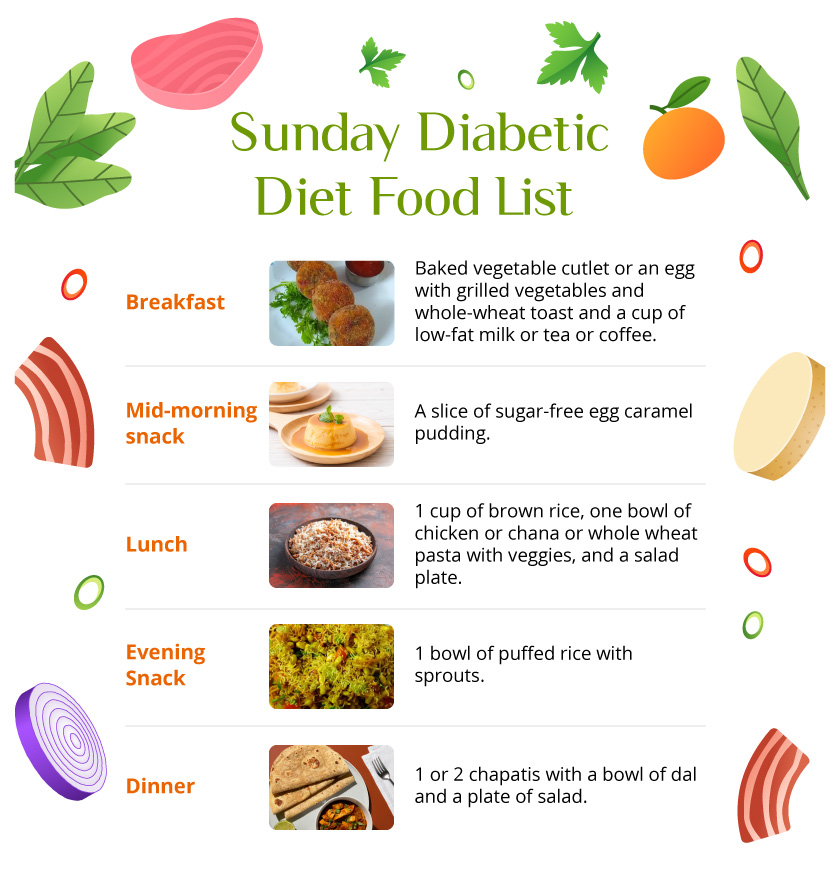
Breakfast - Baked vegetable cutlet or an egg with grilled vegetables and whole-wheat toast and a cup of low-fat milk or tea or coffee.
Mid-morning snack - A slice of sugar-free egg caramel pudding.
Lunch - 1 cup of brown rice, one bowl of chicken or chana or whole wheat pasta with veggies, and a salad plate.
Evening Snack - 1 bowl of puffed rice with sprouts.
Dinner - 1 or 2 chapatis with a bowl of dal and a plate of salad.
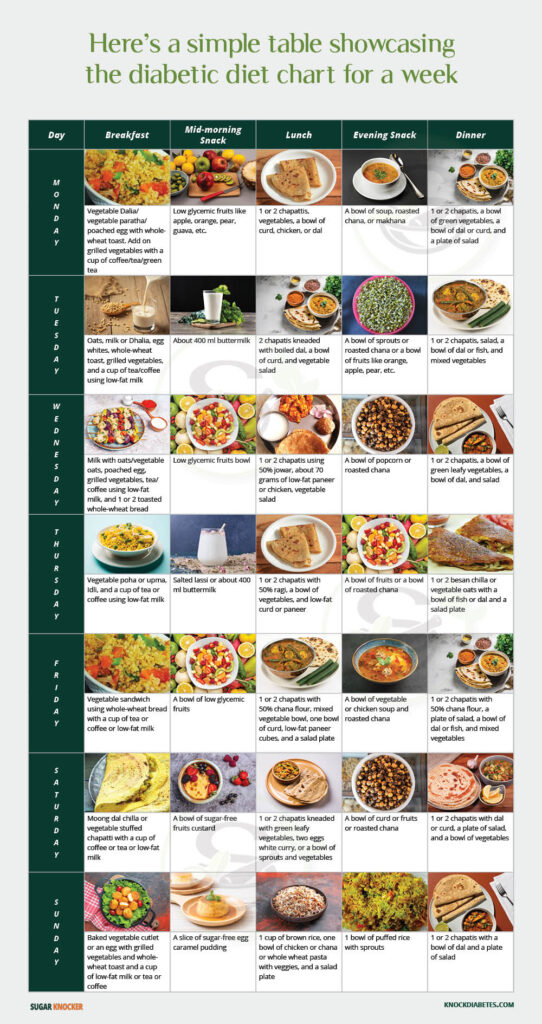
5. Download 7 Days Diabetes Diet Chart for FREE
Note:
- In order to construct an individual diabetes diet chart age, height, weight, degree of exercise, and blood sugar levels are taken into account of the individual.
- The above-suggested sugar patient diet chart is a generic one. For a person with diabetes, a skilled dietician can create a custom food plan.
Managing Blood Sugar Levels with Diet
Monitoring Carbohydrate Intake
Carbohydrate intake plays a significant role in blood sugar management. Counting carbs and spreading them evenly throughout the day can help maintain stable blood glucose levels. Use carb counting tools or consult with a nutritionist to understand the appropriate amount of carbs for your needs.
Understanding the Glycemic Index
The glycemic index measures how quickly foods raise blood sugar levels. Foods with a low GI are better for managing diabetes as they release glucose slowly into the bloodstream. Incorporate low GI foods such as whole grains, legumes, and non-starchy vegetables into your diet.
Try This: Sugar Knocker’s Diabetes Reversal Kit
Tips for Sticking to Your Diabetic Diet Chart
Meal Planning and Preparation
Planning and preparing meals in advance can make it easier to stick to your diabetic diet chart. Create a weekly meal plan, prepare ingredients ahead of time, and cook in batches. This approach saves time and ensures you always have healthy meals ready.
Overcoming Common Challenges
Sticking to a diet can be challenging, especially when cravings hit. To overcome this, find healthy alternatives to your favorite foods, stay hydrated, and keep healthy snacks on hand. Staying motivated by setting realistic goals and rewarding yourself for meeting them can also help.
6. 7 Diabetes Food Myths
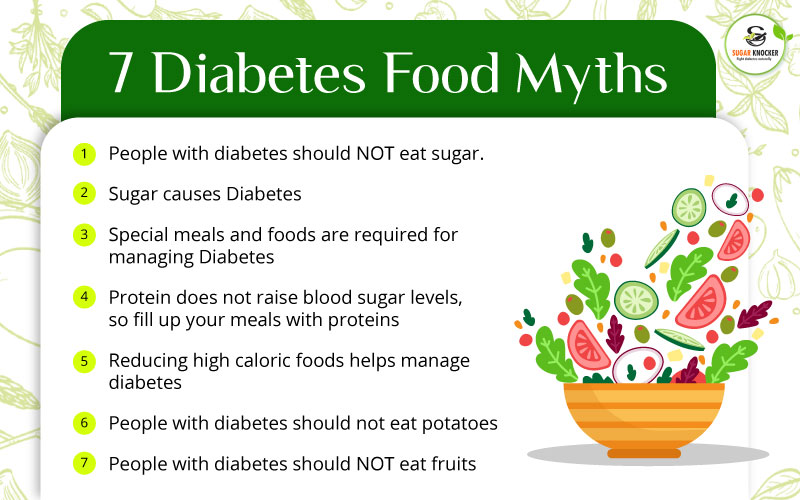
There are numerous misconceptions about the diabetes diet chart, however, each person’s definition of healthy eating may vary depending on their lifestyle, dietary preferences, and medication. We’re here to clarify the myths around nutrition and diabetes and to provide you with the information you need to make an informed decision about your type 1 or type 2 diabetes diet chart.
6.1. Myth 1: Never consume sugar if you have diabetes.
One of the biggest myths regarding the diabetes diet chart is consuming Never consume sugar if you have diabetes. Yes, consuming an excessive number of sweets will cause a blood sugar increase. However, the food chart for diabetes can include sugar.
Instead of focusing on natural or added sugars, overall carbohydrate intake is what helps manage blood sugar.
6.2. Myth 2: Sugar Causes Diabetes
Since diabetes is characterized by elevated blood sugar levels, it has long been believed that consuming sugar somehow initiates the disease process. However, the concept has been disproved by Diabetes UK2 and The American Diabetes Association1. Consuming sugar in balance is an essential part of a healthy diabetes diet chart.
Diabetes is a complicated condition with no known etiology. The condition is influenced by a number of variables, including genetics, age, lifestyle, ethnicity, and food.
6.3. Myth 3: Special Meals and Food are Required for Managing Diabetes
People with diabetes should continue to practice good eating habits and proper exercise just like everyone else. Separate meals and foods are not necessary for diabetics, though.
For regulating stable blood sugar levels, a food chart for diabetes should include protein, healthy fats, veggies, and whole grains are excellent.
6.4. Myth 4: Eat proteins in your meals since they won’t cause any blood sugar levels to rise.
Unlike carbs, proteins do not affect blood sugar levels. However, there is a certain quantity of protein that should be included in their diabetes diet chart.
A macronutrient that keeps you feeling full after meals is protein. You would be able to lose weight more quickly and successfully if you ate a diet high in protein. However, if the protein is not used to create muscle, it will turn into calories. A high protein diet may also result in unfavorable lipid profiles, which raises your chance of developing cardiovascular disease.
6.5. Myth 5: Diabetes can be controlled by consuming fewer high-calorie meals.
The amount of carbohydrates your body needs depends on your age, level of exercise, and weight. The greatest notable impact on blood sugar levels is caused by carbohydrates. Knowing the appropriate quantity for you is so crucial.
Try visiting a skilled dietician to know your type 2 diabetes diet chart.
6.6. Myth 6: Potatoes should not be consumed by diabetics.
Both white potatoes and sweet potatoes are good sources of nutrients including fiber, magnesium, potassium, B vitamins, and others. A good source of fiber, magnesium, Vitamin B-6, and other minerals is whole-grain brown or wild rice. So, consume them as per your diabetes diet chart.
6.7. Myth 7: Fruits should not be eaten by diabetics.
There are no fruits that diabetics should avoid. If you have diabetes, any fruit can be added to your diabetes diet chart if the portions are correct. Fruit options can include fresh, frozen, canned, or dried fruit. Fruits provide fiber, potassium, vitamin C, and other beneficial nutrients that keep your body healthy and help prevent disease.
7. Diabetic Diet Chart of Do’s and Don’ts
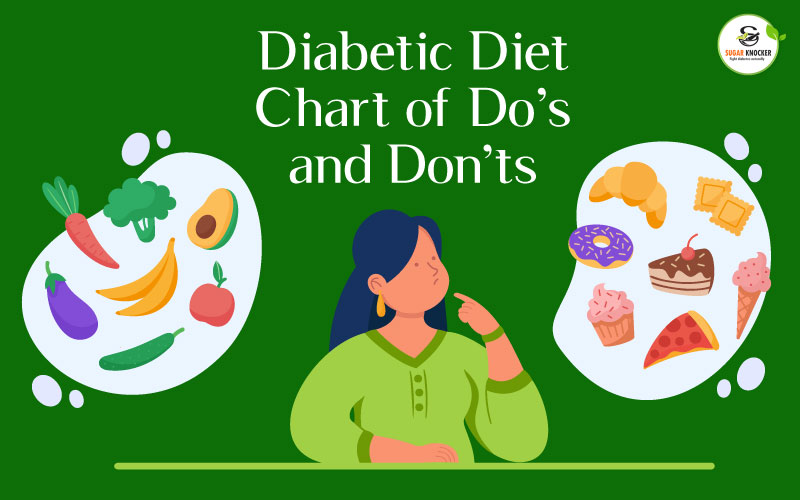
7.1. DOs for Diabetes Diet
- Rather than 3 huge meals, eat 4-6 smaller ones.
- Follow an individualized best diet plan for diabetes patients.
- For improved postprandial sugar management, consume whole-grain, high-fiber meals (cereals, legumes, and green vegetables).
- People with diabetes should be able to gain or lose weight while adhering to the calorie requirement.
- Vegetables are low in fat, salt, and calories while being a great source of vitamins and minerals.
- Consume no more than 1-2 servings of fruit every day.
- Include mostly meals with a low GI.
- Chew your meals thoroughly and get enough water each day.
- Limit your intake of processed foods and table salt.
- DON’T forget to exercise daily.
- Steer clear of foods high in saturated fats such as butter, ghee, coconut oil, and palm oil.
7.2. Don’ts While Following a Diabetic Diet Chart:
- Avoid processed meals, white bread, potatoes, rava, maida, and other products made with starchy or refined flour.
- Avoid fried veggies since they add extra calories, fat, and carbohydrates to your diet.
- Avoid eating sweet fruits including bananas, mangoes, custard apples, and sapodillas.
- Stop drinking colas and fruit drinks with added sugar.
- Do not put off visiting the doctor or regular checkups.
- Stop smoking.
- Avoid white rice and Indian sweets like halwa and laddoos. Also, stay away from deep-fried foods. They cause a rapid rise in blood sugar.
8. Prevalence of diabetes in India
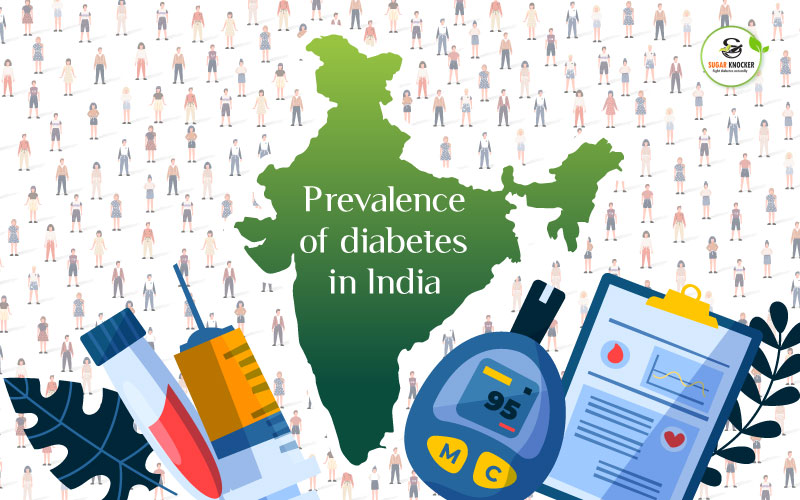
According to WHO, in India, it is estimated that 77 million adults over the age of 18 have type 2 diabetes and that almost 25 million are prediabetics (with an increased risk of getting the disease in the near future).
[Understanding Vitamin Deficiency in Diabetes: A Comprehensive Guide]
More than 50% of people may not know they have diabetes, which can cause serious health problems if not caught early and managed.
Adults with diabetes are two to three times more likely to get a heart attack or stroke. Neuropathy (nerve damage) in the feet raises the risk of foot ulcers, infection, and ultimately the requirement for limb amputation when combined with decreased blood flow.
Diabetes may lead to significant health issues. The health issues consist of:
- Cardiovascular diseases
- Foot ulcer
- Nerve damage
- Kidney damage
- Liver damage
- Multiple organ failure
- Cognitive impairment and
- Death
- Strokes
You May try this: Herbal diabetes capsules: Sugar Knocker Buy 2 + Get 1 Free
9. Bonus tips to control diabetes
- According to the doctor’s advice, exercise frequently.
- Limit your carbohydrate consumption.
- Consume more fiber
- Hydrate yourself by drinking water.
- Make use of a glucometer to check your blood sugar levels frequently, and keep track of the results.
- Pick foods that have a low glycemic index.
- Plan routine eye tests and physicals.
- Maintain good oral hygiene.
- Keep an eye on your feet.
Also read : Essential Guide to a Pancreatitis Diet: Foods to Eat & Avoid
10. Conclusion
Individuals with diabetes can live typical lives just like everyone else. All they have to do is educate themselves on the complexities of diabetes management. They must be aware of the dietary adjustments that can aid in blood sugar regulation.
It is advised to speak with a dietitian to learn about portion management and calorie monitoring and to create a personalized diabetes meal plan. You can be successful if you strictly adhere to the sugar patient diet chart, engage in regular exercise, and take your anti-diabetic medications as directed.
11. Frequently Asked Questions:
Q: Can I control my Sugar by following a diabetes diet chart?
A: If you have borderline diabetes, you may manage your blood sugar levels naturally without using medication by adhering to a food chart for diabetes and leading an active, healthy lifestyle. However, you must routinely check your blood sugar levels and visit your doctor for updates. Additionally, if your doctor advises you to take diabetic medication, then follow it timely.
Q: What Indian foods are healthy for diabetics?
A: Increase your intake of high-fiber foods if you have diabetes. Soluble fiber is a form of fiber that may aid with blood sugar regulation. Along with that, it is suggestible to consult a skilled dietician and get a personalized diet chart for diabetes patients.
Q: Can people with diabetes eat rice?
A: White rice has a lot of carbohydrates, which might cause blood sugar levels to rise. Rice that has been cooked using the straining process may have less starch. Due to their high vitamin content and high fibre content, brown rice is a fantastic alternative to white rice.
Q: What should I eat according to my type 2 diabetes diet plan?
A: Eating a range of healthful foods from all the food categories is essential for managing diabetes: veggies and fruits. entire grains including quinoa, oats, brown rice, barley, and whole wheat. proteins, including tofu, lean meats, fish, eggs, nuts, beans, lentils, and chicken.
Q: Which Dal is good to include in best diet plan for diabetes patient?
A: Patients with diabetes, cardiovascular conditions, and hypothyroidism benefit from green gramme dal, often known as “Moong dal.” In order to manage metabolic syndrome, this is a viable alternative.
Our Blogs:
10 Healthy Drinks for Diabetes: Tasty Options and Better Health
Effective Diabetic Diet Chart for Better Health Management
Ayurvedic Treatment for Diabetes: Effective Natural Solutions
